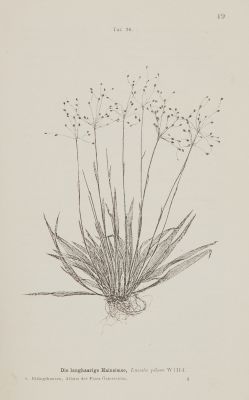
Title
Taf. 4 Der gemeine SchildfarnArtist
Ettingshausen, Constantin (Austrian, 1826-1897)Publication
Photographisches Album der Flora ÖsterreichsDate
1864Process
Pretsch glue-chromate typographic processAtelier
k. k. Hof- und StaatsdruckereiImage Size
16.5 x 7 cmSheet Size
23.8 x 15 cm
The plates in this work began life as nature prints; they were then reduced by photographic means and then again reproduced by a newly invented typographic process. They have a curious appearance halfway between nature printing and lithography.
From the introduction… It is a wish that nature lovers have often voiced that photography, which has acquired such great importance in everyday life, should also be used for the depiction of true images of natural products. All ideas and attempts to equip botanical works with photographs have so far failed, apart from the inconvenience and costly nature of the duplication, mainly due to the hindering circumstance that, because of the predominantly green color of the objects only shadow images and almost no detailed drawings at all.
Only nature self-printing proved to be an excellent means of achieving completely successful and usable photographic representations of plants. Just out from the k. k. Hof- und Staatsdruckerei the beautiful and valuable invention that emerged from the court and state printing works, of duplicating photographs with the usual letterpress press, now realized my long-cherished intention of publishing a comprehensive work about the local flora, illustrated with photographs, into the public domain. It is intended to give the layperson the means to get to know plants in an easy way, but also to offer him a sufficient opportunity to go into the scientific justification of what has been won.
The beautiful and valuable invention were "halftone" plates for typographic printing, which had been made by the glue-chromate process and electrotyped and was invented by Paul Pretsch. The process was exhibited at the London World Exhibition of 1862. [1]
Ettingshausen is a well known figure in the early history of nature-printing; together with A. Pokorny he produced a book of 500 nature prints in 1856 entitled Physiotipia plantarum austriacarum.
Reproduced / Exhibited
OCLC locates only two copies, one in France and one at the U of Ill. Nissen BBI 608
References
[1] Josef Maria Eder in his book: History of Photography (Dover, 1972), pg 583.




